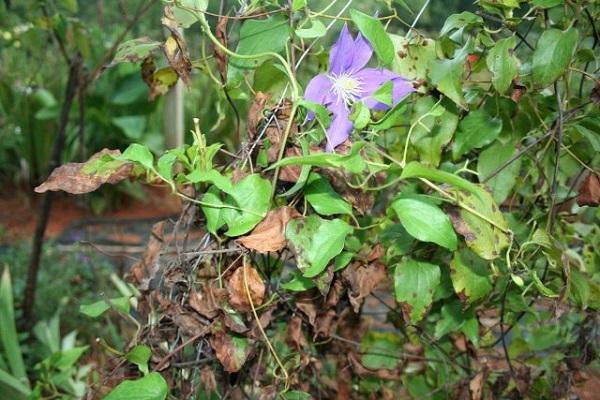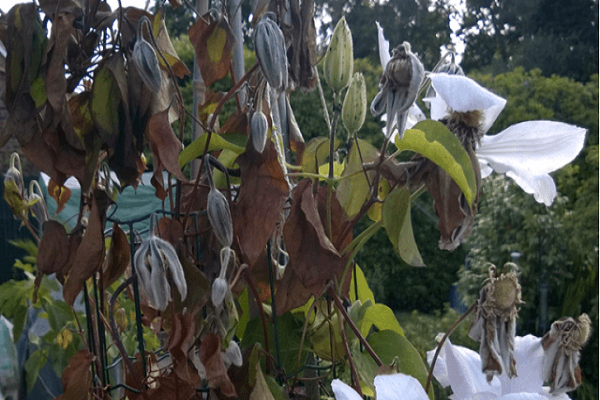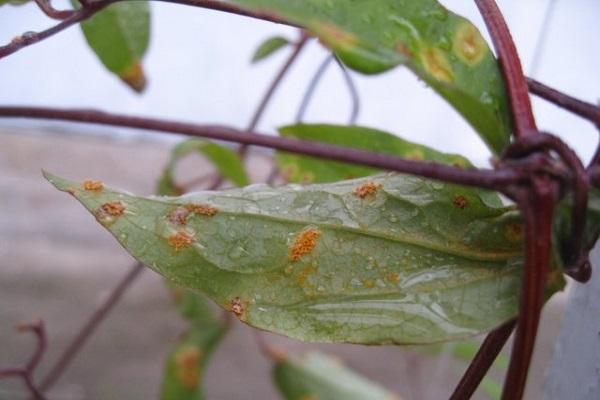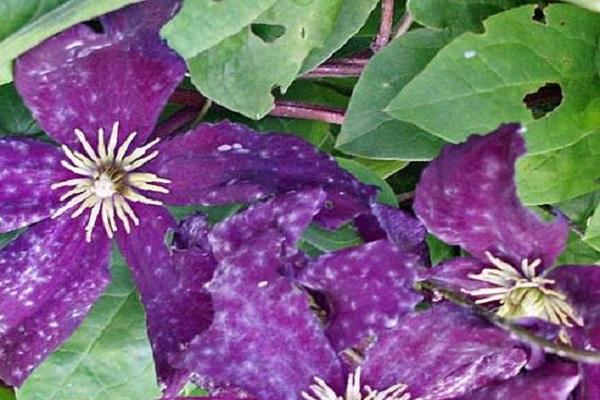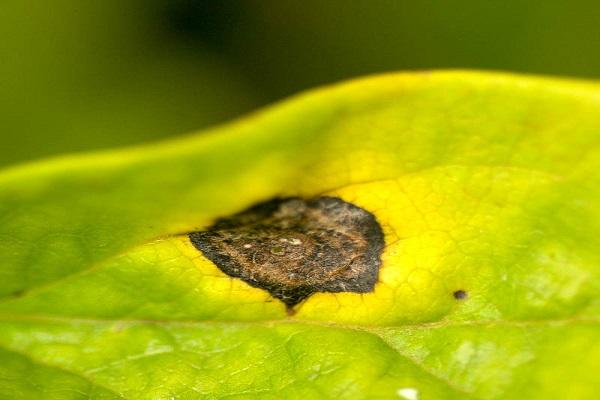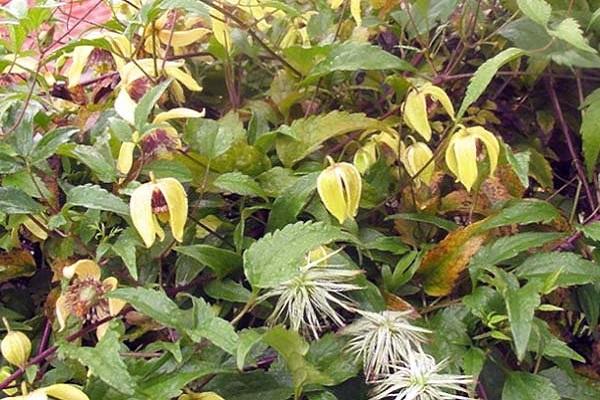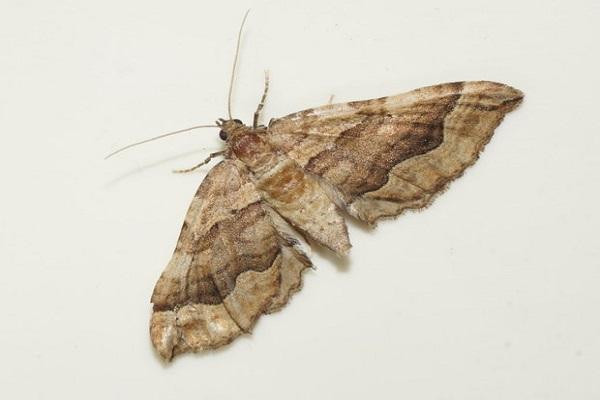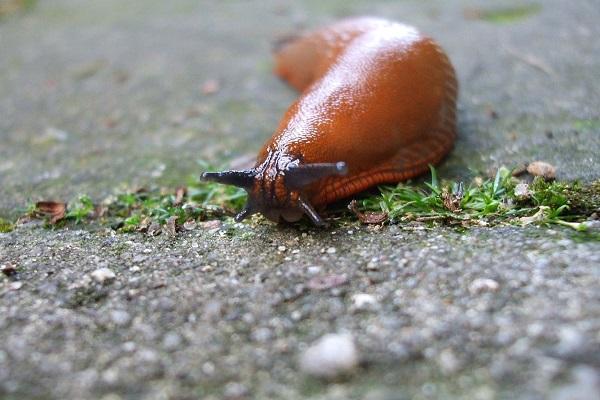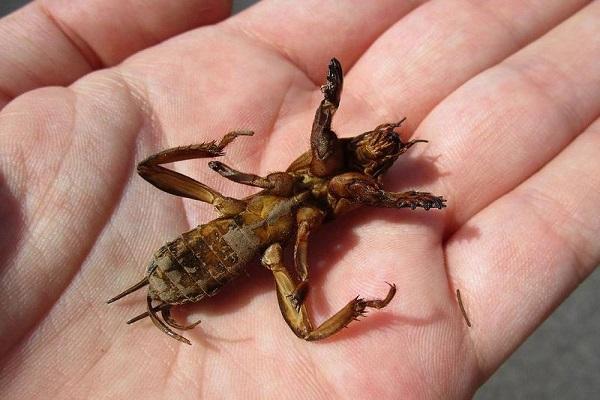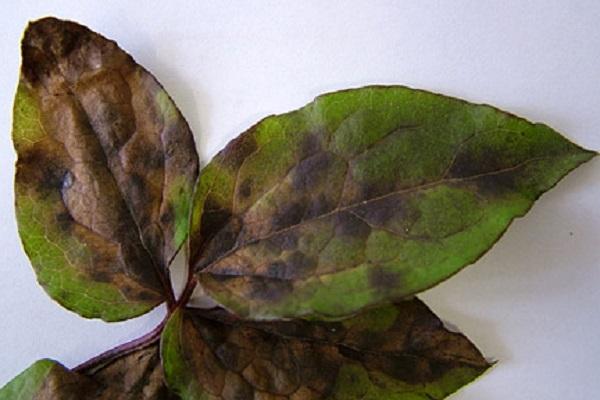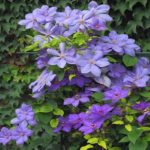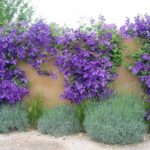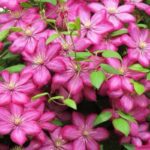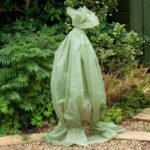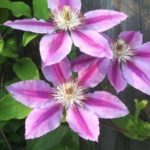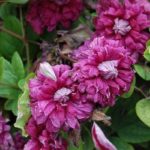Diseases and pests of clematis can nullify all the work and efforts of gardeners. Fungi and viruses cause yellowing and falling of leaves, and provoke the dropping of buds and flowers. Timely preventive measures save clematis from microscopic enemies. To increase resistance, plants are regularly fed with organic matter and minerals. Insects are controlled before and at the time of their appearance on clematis.
- Clematis diseases and their treatment
- Fungal
- Fusarium
- Wilt or verticillium wilt
- Phomopsis wilt
- Rust
- Gray rot
- Powdery mildew
- Ascochyta blight
- Alternaria blight
- Septoria
- Cylindrosporiosis
- Viral
- Flower pests and their control
- Nematodes
- Aphid
- Spider mite
- Window moth
- Real small moth
- Mealybug
- Slugs and snails
- Bedbugs
- Shields
- Medvedki
- Mice, rats
- Why do the lower leaves of clematis dry out?
- Clematis turns black and dries out
- Preventive actions
Clematis diseases and their treatment
When growing clematis, it is necessary to follow all agrotechnical measures: timely fertilize the soil, loosen the soil, disinfect the soil, remove weeds, water the plants moderately. Even good care cannot protect this climbing shrub from disease. Rainy weather, drought, and prolonged cold weather can trigger the development of fungal or viral diseases.
True, a healthy plant growing on fertile soil is easier to resist viruses and fungi, and it has higher immunity. Preventive measures will help you avoid many diseases.
Fungal
Various kinds of microscopic fungi, parasitizing the plant, lead to metabolic disorders, yellowing and drying of leaves, falling of buds and flowers, and wilting of the entire bush. Modern fungicides and preparations with copper help to cope with fungal infections. The disease most often occurs in acidic soil, so in the spring the soil where you plan to plant clematis needs to be limed.
Fusarium
This disease is caused by fungi of the genus Fusarium. The pathogens live in the soil and infect the lower part of the stem. Mycelium develops from fungal spores, clogging the conducting vessels. Because of this, metabolism is disrupted, the plant does not receive nutrients, and even applying fertilizers or timely watering does not help avoid wilting.
In the spring, as a preventative measure, the plant and the ground around it should be treated with solutions of copper or iron sulfate, fungicides (Fundazol, Topaz, Ridomil Gold).Treatment is carried out with Trichodermin or Polycarbacin.
Wilt or verticillium wilt
The causative agent of this fungal disease is the fungus Verticillium dahliae Kleb. It lives in the soil and parasitizes the lower part of the shoot. The stem at the base darkens, the plant itself, due to the activity of the fungus, does not receive nutrients and withers. At the same time, there are no signs of fungal disease on the clematis itself. The disease progresses slowly.
Preventive treatments with fungicides Fundazol, Topaz, Skor, and Bordeaux mixture help reduce the likelihood of wilt. For treatment, the drugs Trichodermin or Polycarbacin are used.
Phomopsis wilt
The disease is caused by a fungus of the genus Phomopsis. The disease is dangerous for large-flowered varieties and can lead to the death of the bush. Small-flowered varieties can bloom despite the presence of fungus. The first signs of damage can be seen in early summer. Brown spots appear on the lower leaves, which spread throughout the entire leaf blade. The fungus may appear on the stems of clematis or along the edges of the opened petals.
Affected shoots and leaves become brownish, dry out and wither. The main thing is to identify the infection in time and remove the diseased parts of the plant.
Clematis must be treated with Previkur fungicide.
Rust
Fungal infection caused by the fungus Aecidium clematidis DC. Bright orange, loose spots appear on the leaves and stems; they grow and merge with each other. The parasitic activity of fungi causes the leaves to curl and dry out. Infected parts of clematis should be picked and burned. To save from rust, use fungicides (Topaz, Gamair, Hom) or Bordeaux mixture.
Gray rot
Fungal disease caused by the pathogen Botrytis cinerea Pers. The infection spreads in rainy and cool weather. The fungus overwinters on weeds left in the field. The disease can be provoked by dense plantings or an abundance of nitrogen in the soil. Brownish spots appear on the leaves of clematis, then they become covered with a gray fluffy coating. Diseased parts of the plant must be carefully picked off. To prevent the disease, the foliage is sprayed with a suspension of copper oxychloride or fungicides (Gamair, Fundazol, Azocene). In spring, the ground is watered with a solution of copper sulfate.
Powdery mildew
A fungal disease in which leaves and flowers become covered with a white powdery coating. Then brownish spots appear. Leaves and flowers dry out and fade. Before treating clematis, you need to remove all parts of the plant affected by the fungus. A diseased bush can be treated fungicides Baktofit, Topaz, Fitosporin. As a preventative measure, in the spring the ground should be watered with a solution of copper sulfate.
Ascochyta blight
The causative agents of this disease, which causes leaf spot, are fungi of the genus Ascochyta. Pycnidia are visible in the center of the brown spots. Subsequently, due to necrosis, the tissue falls out and holes appear on the leaves. Diseased leaves should be torn off and burned. As a preventative measure, the bush is sprayed with a solution of copper or iron sulfate. For treatment, use Bordeaux mixture or a suspension of copper oxychloride.
Alternaria blight
A disease caused by fungi of the genus Alternaria. Optimal conditions for infection are hot weather and short-term night precipitation. The leaf affected by the fungus becomes covered with numerous brownish spots, dense to the touch. Infection can penetrate wounds and damaged parts of the plant.Diseased clematis need to be treated with Bordeaux mixture and fungicides (Kuproksat, Abiga-Pik, Ridomil MC). The affected parts of the plant must be picked and destroyed.
Septoria
A disease caused by the Septoria fungus. Fungal spores live on plant debris. Affected leaves become covered with brownish-gray spots of irregular shape. Diseased parts of the plant dry out, the stems wrinkle and turn brown. As a preventive measure, the soil is watered with a solution of Trichodermin, Glyokladin, Rovral. Treatment of diseased plants is carried out using Fundazol, copper sulfate, drugs Skor, Hom, Ridomil Gold, Previkur.
Cylindrosporiosis
The fungal infection affects all above-ground parts of the plant. Light green spots appear on the leaf blades, subsequently they increase in size and become brownish. Later, these spots crack, the leaf becomes deformed and dies. The buds of diseased clematis darken and fall off without opening. The disease becomes more active in rainy and cool weather. To combat infection, fungicides (Hom, Gamair) and Bordeaux mixture are used.
Viral
Clematis are rarely affected by viruses. Insects (aphids, caterpillars, ticks) pose a danger; they are carriers of dangerous infections. They can infect clematis with yellow mosaic. Diseases caused by viruses lead to gradual withering of the plant. First, the leaves are affected: light spots appear, the leaf blades turn yellow, dry out, curl, and die. Flowers lose their characteristic color.
All affected parts of the plant must be picked and burned. As a preventive measure, plants are treated with insecticides. To improve immunity, shrubs are fed with complex fertilizers.
Flower pests and their control
Clematis and its roots contain toxic substances, so this plant is not attractive to insects. However, there are many pests that attack shrubs.
Nematodes
The main insect pest of clematis is the root-knot nematode. This is a microscopic worm that lives in the soil. It penetrates into the roots and forms thickenings (galls) there. The plant absorbs nutrients poorly, growth slows down, the leaves become small, the stem becomes brittle, the buds fade and become deformed. Some types of nematodes feed on clematis leaves. The leaf blade wrinkles, turns brown, and dries out. These insects can be controlled using chemicals (BI-58, ROGOR, Dimethoate). Mulching the soil with mint and wormwood helps get rid of nematodes.
Aphid
Tiny soft-bodied insects that settle in colonies on the underside of leaves. They feed on plant sap. The vital activity of these insects leads to yellowing, drying out, and curling of the leaves. Spraying with a soap solution or the preparations Fitoverm, Aktara, Aktellik helps against aphids.
Spider mite
A small yellow or reddish insect that spins a web on the underside of a leaf. It feeds on plant sap and spreads viral diseases. As a preventive measure, it is recommended to periodically spray the bush with cold water. Actellik, Antiklesch, Akarin saves from the presence of spider mites. For prevention, clematis is sprayed with garlic infusion.
Window moth
Small reddish butterflies with dark spots on their wings. They fly mainly at night. They lay eggs from which caterpillars emerge. They eat leaves, flowers and stems of clematis. To combat caterpillars, insecticides are used: Bitoxibacillin, Iskra-M, Inta-Vir.
Real small moth
A butterfly with light greenish wings, from whose eggs light green caterpillars hatch. Insects feed on clematis leaves. The caterpillars are collected from the plant and destroyed. For prevention, the foliage is sprayed with a solution of Karbofos, Nitrafen, Bitoxibacillin.
Mealybug
A small, white, hairy insect that feeds on plant sap. For prevention, the foliage is sprayed with Karbofos solution, garlic infusion, and a mixture of water and olive oil.
Slugs and snails
Elongated light brown slugs and snails eat the leaves and stems of clematis at night. During the day, these insects hide from the sun under fallen dry leaves, stones, and snags. Pests become more active in wet weather. For slugs and snails, use the granular preparation Ferramol, which is scattered over the surface of the soil. Clematis foliage is sprayed with a solution of ammonia.
Traps are made with the drug Metaldehyde. Insects are collected by hand. The ground around the bush is mulched with crushed shell rock and fine gravel.
Bedbugs
Small brownish or orange-black insects that feed on plant sap. Dark spots appear on the leaves, then they turn yellow and dry out. Spraying foliage with Aktara helps prevent bedbugs.
Shields
A small insect whose body is covered with a brownish shield of wax. The scale insect feeds on the sap of the plant, causing the leaves to dry out and fall off. You can save clematis from insects by spraying with insecticides (Aktara, Karbofos).
Medvedki
Large brown insects that live in the soil and dig holes in it. They feed on clematis roots and young seedlings.The soil in which mole crickets live must be watered with a soap solution or insecticide (Metarizin, Boverin, Anti-mole cricket).
Mice, rats
Rodents can damage the root system and shoots of clematis. Traps and repellers are set against them, and poisoned baits are scattered. You can plant it near clematis imperial hazel grouse, black root, coriander, tansy. Rodents cannot stand the smell of these plants and leave the area. Rodenticides (Storm drug) and Vishnevsky ointment help against rodents.
Why do the lower leaves of clematis dry out?
Yellowing and drying of the lower leaves of clematis can be caused by a fungal infection. To prevent the spread of the fungus, the shrub is treated in the spring with a fungicide solution (Trichodermin, Fundazol, Fitosporin-M), and the ground is watered with Bordeaux mixture. Clematis leaves may dry out due to a lack of nutrients in the soil. The plant needs to be fed with organic matter, nitrogen or complex fertilizers.
Clematis turns black and dries out
Clematis leaves may turn black and dry out due to wilting caused by a fungal infection. To prevent the disease in the spring, the soil should be watered with lime milk, a solution of copper or iron sulfate. The foliage must be treated with fungicidal agents (Fundazol, Topaz, Gamair, Previkur).
Preventive actions
Clematis will get sick less often if you constantly care for the area: remove weeds and prevent the soil from becoming waterlogged. It is not recommended to overfeed the shrub with nitrogen fertilizers. Substances containing ammonia (ammonium nitrate or ammonium sulfate) can be added to the soil.
In early spring, the ground can be watered with Bordeaux mixture, lime or copper sulfate solution.For the purpose of prevention, the foliage is sprayed 2-3 times per season with solutions of fungicides (Trichodermin, Glyokladin, Topaz, Fitosporin-M, Hom, Gamair, Fundazol).

